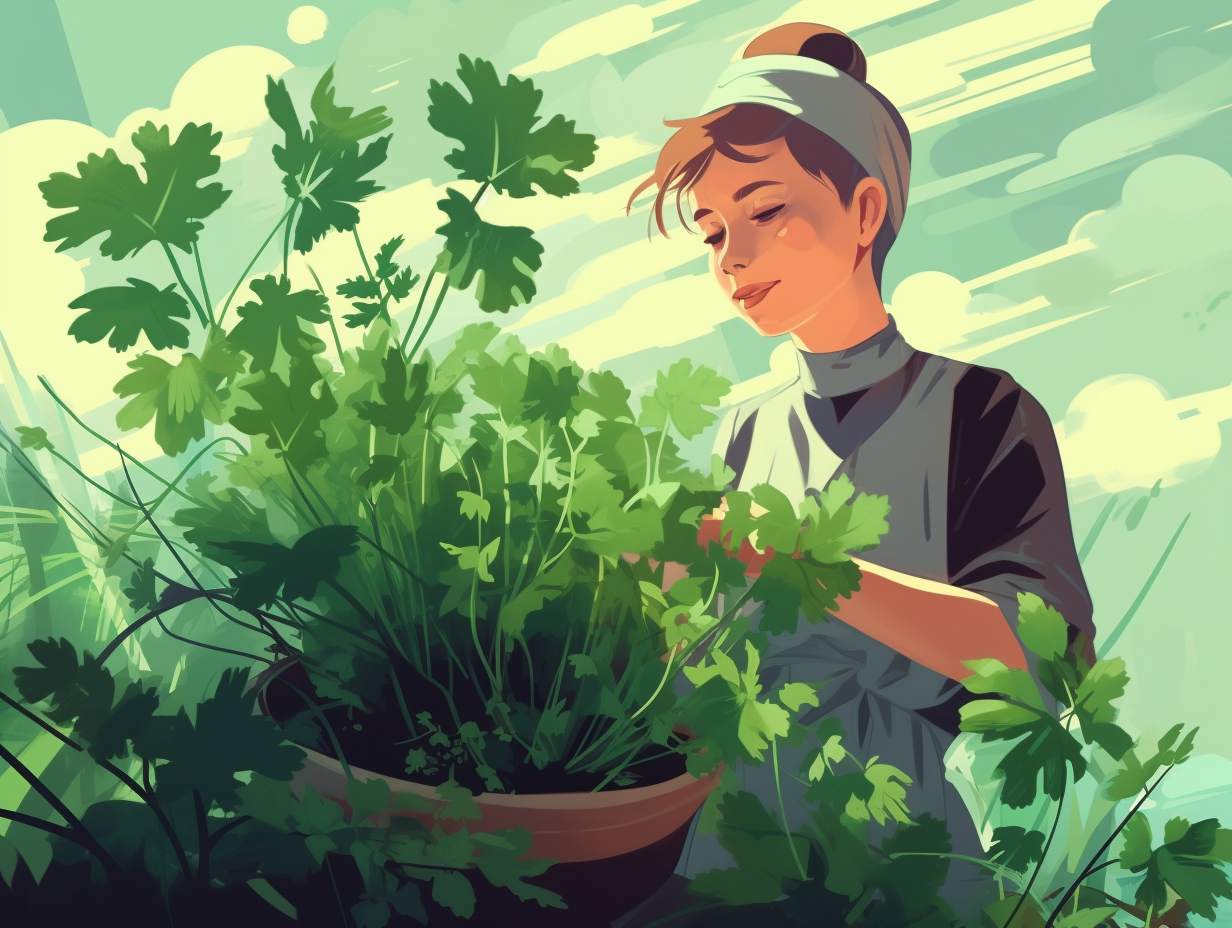Top 15 Cilantro Fun Facts: Unraveling the History, Origins, and Surprising Uses of this Flavorful Herb

1. Genetic Cilantro Conspiracy
Cilantro: the herb that divides dinner tables and turns friends into frenemies faster than a reality TV show reunion. But, is it really a matter of taste, or are some people just born with a distaste for this polarizing plant? The plot thickens: Turns out, a genetic variation, known as the OR26A gene, causes some individuals to perceive the flavor of cilantro as bitter and metallic – even culinary icon Julia Child was in on this genetic conspiracy, famously picking cilantro out of her dishes due to this inborn peculiarity.
Source => forbes.com
2. Soapy Taste Bud Fate
Cilantro: the herb that's not mint to be soaped: In an amusing twist of taste bud fate, medical studies have found that some individuals have a genetic predisposition that causes cilantro to taste like soap or metal, creating a love or hate relationship with the divisive herb.
Source => bhg.com.au

Did you know? Parsley is a secret superfood with mighty powers - it's full of vitamin K, helps fight inflammation, and could even combat cancer! Discover more amazing facts about this undercover hero.
=> Fun Facts about Parsley
3. Ancient Cilantro Plot Twist
Cilantro, the ultimate ancient plot twist: It turns out this feisty little herb, commonly found in your favorite tacos and stir-fries, was not only BFFs with the Egyptians, hanging out in tombs like a VIP, but also earned a shoutout in Sanskrit texts and survived the Mayflower's brutal cruise to become one of the first plants the American colonists cozied up to. Today it tickles our taste buds across myriad cuisines, making us giggle with delight or scrunch our noses in soapy horror in equal measure.
Source => chefs-garden.com
4. Soapy Mouth Challenge
Ever heard of the "soapy mouth challenge"? No? It's not a trendy internet sensation, but rather an accidental culinary misadventure: Some people have a genetic variation that causes cilantro to taste like soap due to a specific olfactory receptor gene called OR6A2, making them victims of suds-like flavors in their dishes. Central America and India seem to be winning the genetic lottery on this one, though, as the aversion is less common in those regions where cilantro plays a starring role in the kitchen.
Source => xcode.life

5. Mummy's Favorite Herb
From secretly spicing up Egyptian mummies’ afterlife parties to tickling the fancy of ancient Chinese medicine practitioners: Cilantro, a.k.a. the herb of many surprises, has been gracing humanity's gardens and taste buds since the days of the pharaohs, who were keen on taking its seeds to the grave with them.
Source => hort.extension.wisc.edu
6. The Gene-ious Cilantro Divide
Ever wondered why cilantro parties always seem divided between die-hard fans and soapy-faced skeptics? There's a gene-ious explanation for it: A genetic variation causes some people to perceive the taste of cilantro as soapy, due to the presence of a flavor compound called aldehyde, also found in soap-making ingredients.
Source => isabeleats.com
7. Bacteria Battler Super Cilantro
If cilantro were a superhero, it would be called "The Bacteria Battler", swooping in to save your taste buds and stomach from the diabolical pathogens lurking in your spicy burrito: Cilantro contains a compound called dodecenal and eight other antibiotic-type compounds that work together to combat food poisoning caused by bacterial villains like salmonella, dysentery, cholera, and listeria – proving to be just as effective as the antibiotic gentamicin.
Source => integrativemedicineofnj.com
8. Cold-hearted Garden Diva
Though cilantro might be the green life of the salsa party, it remains a sensitive cold-hearted diva in the garden scene: Cilantro thrives best during the chillier days of early spring and fall, avoiding the sweltering heat and thirst of summer months lest it bolts and ruins its flavorful reputation.
Source => creativevegetablegardener.com
9. Cilantro's Bug Hero Adventures
Cilantro: the unsung hero of the bug world, starring in the blockbuster hit "The Adventures of Pest Control and Ladybug Love" every spring: This flavorful herb not only jazzes up your tacos and guacamole but also serves as a bug magnet, attracting beneficial insects like ladybugs, lacewings, and parasitic wasps that keep pesky garden villains at bay while providing early sources of pollen and nectar for their insect-party to get buzzing.
Source => gardenclub.org

10. Herb of the Year Sensation
Before being crowned prom queen, Cilantro had an even greater claim to fame: the International Herb Association declared it the Herb of the Year™ in 2017. After rising from its humble beginnings in India and China, this verdurous Victoria made its way to Mexico and Peru, flourishing under the sun and settling in like a houseplant at home. But be warned, dear reader, lest your spice cabinet become as bland as a boiled potato, for drying shall curse Cilantro with a fate akin to flavorlessness. No, the true riches lie in partaking fresh from its leafy greens or retrieving it from the frozen catacombs of your refrigerator.
Source => hort.extension.wisc.edu
11. Cilantro's Super-Spice Duality
Cilantro: the Clark Kent of herbs, masquerading as a mild-mannered leaf in your Mexican dishes, then soaring to super-spice status as coriander in Indian cuisine! The serious reveal: Cilantro is not just a dual-purpose herb, but also a cool season plant that thrives in spring and fall, even surviving light frosts. It struggles in hot temperatures but can be grown continuously by planting seeds every couple of weeks and maintaining well-drained, slightly acidic soil with a pH of 6.5. Cue the capes and spandex, cilantro is here to save your dishes!
Source => canr.msu.edu
12. Cilantro & Coriander's Family Secret
In a tale of doppelgängers and culinary espionage, it turns out cilantro and coriander have been fooling us all along – sharing DNA and conjuring up global flavors: Both the fragrant leaves and mysterious seeds come from the same plant, stealthily infiltrating Mexican, Indian, and Middle Eastern cuisines as part of the Apiaceae family – living it up with their parsley and dill cousins.
Source => buncombemastergardener.org
13. Cilantro, Coriander & Their Flavor Swindle
Cilantro and coriander walk into a bar, and prepare to blow your mind with their family connection: Cilantro actually refers to the leaves of the very same plant that gives us coriander seeds, but they taste as different as night and day, with cilantro flaunting a citrusy zest and coriander opting for a mellow sweetness with a dash of curry-esque charm.
Source => purewow.com
14. The Soapy Taste Club
If you've ever been bamboozled by the polarizing taste of cilantro, feeling like you've just chomped on a bar of soap, know that you aren't alone – a soapy surprise awaits many, depending on their genes: Approximately 20% of East Asians possess the gene variation responsible for causing the infamous soapy sensation, while fewer individuals carry the trait in regions like Central America and India where cilantro is most cherished. Fear not, cilantrophobes, for hope emerges in the form of crushed herb exposure therapy to help acclimate your taste buds to the culinary whimsy of cilantro.
Source => britannica.com

15. Party Animal Herb Benefits
Cilantro, the notorious party animal of the herb world, brings more to the table than its love-it-or-hate-it dance on your tastebuds: This green fiesta is jam-packed with the antioxidant quercetin, known for boosting immunity, supporting gut health, and delaying the aging process by clearing out damaged cells, while also combatting inflammation and reducing the risk of chronic illnesses like heart disease.
Source => wellandgood.com
Related Fun Facts




















